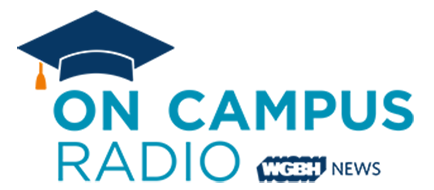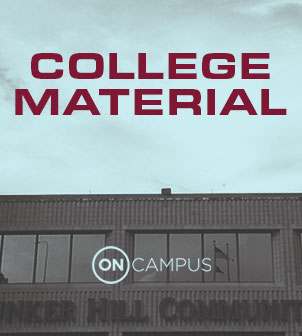
Jasmin Matos, a junior at Northeastern, says the cost of college would be out of reach without scholarships and financial aid.
It's been two weeks since President Obama proposed his sweeping plan to make college more affordable. Now, low-income students and their advocates are urging Congress to support it.
The president wants to create a college rating system that ties federal financial aid to colleges' performance outcomes, including their ability to increase access for nontraditional students.
Reactions to Obama's plan to rank colleges have been mixed.
It's a rite of fall at every college and university: At Northeastern University, green Peter Pan buses arrive on campus. Students carrying duffle bags and laptops spill out.
"They’re bringing people to my school!" said Jasmin Matos, gliding across this urban campus toward her dorm inside a high-rise here on Boylston Street.
Matos is the daughter of Dominican immigrants. Before Northeastern, Matos attended a low-performing, underfunded high school in Lynn. Her guidance counselors encouraged her to keep her expectations in check – to apply to community colleges.
"It makes sense, because obviously this is more expensive than a community college, so I don’t think that they had bad intentions, because they were aware of the socioeconomic conditions of the students that go here," she said.
For Matos, enrolling at Northeastern seemed like an impossible dream, but she won a scholarship that covered her undergraduate education. Without it, she doesn’t know how she would have covered tuition.
"Hoo! I don’t know the numbers," she said. "I try not to look at them too much. But in total, I think it’s around $55,000."
That's $55,000 a year. Tough to manage for most families. Even tougher if you’re from Lynn, where the median family income is almost one-third of the statewide average.
"If all of us saved our pennies for a year," Matos figured. "Possibly. But it definitely is not realistic."
If you just look at the sticker price at colleges, none of it is realistic. It’s out of reach. The problem is, once students graduate, many of them are struggling to repay their loans because their repayment plans are structured without consumer protections.
So to make sure minority, low-income students like Matos continue to access college, President Obama announced a slew of reforms last month.
"Colleges that keep their tuition down and are providing high-quality education are the ones that are going to see their taxpayer dollars go up," Obama said. "It is time to stop subsidizing schools that are not producing good results, and reward schools that deliver for American students and our future."
Speaking to a welcoming crowd of students at the University of Buffalo, the president said he wants to use federal financial aid to help curb college costs.
"I think we should rate colleges based on opportunity," he said. "Are they helping students from all kinds of backgrounds succeed? And on their outcomes. On their value to students and parents, so that means how much debt does the average student leave with? How easy is it to pay off? How many students graduate on time? How well do those graduates do in the workforce? The answers will help parents figure out how much value a college truly offers."
For decades, higher-ed economist Richard Vedder at Ohio State University has been studying that value question, and he likes the president's idea to provide more information to consumers who are considering college, and who are accumulating more and more debt to pay for it.
"I appreciate the fact that he’s calling attention to this problem," Vedder said. "At the same time, there wasn’t anything in his remarks that is going to change the course of higher education in the next two or three years."
Vedder says the federal government might be more part of the problem than the solution to escalating college costs, so what does he think of the president’s proposal to tie federal financial aid to college ratings?
"The devil is in the details," Vedder said. "There are a lot of problems with this. For example, basing college on these rankings partially or largely on graduation rates could lead to nothing more than grade inflation and higher graduation rates that do not reflect learning but rather qualitative decline."
The president’s plan, Vedder says, doesn’t deal with the fundamental problems facing colleges and universities. The real issue, Vedder says, is federal financial aid that inflates the cost of college.
Others agree that spending is out of control, but they support Obama’s plan.
Judith Scott-Clayton, professor of economics and education at Columbia University, is excited about the president’s initiative, although she says it will be difficult to get the method for rating colleges just right.
"I'm hoping that we can turn the conversation from why this headline proposal is broken to what we might be able to do that would work," Scott-Clayton said. "Such as the president’s suggestion of expanding the pay-as-you earn student-loan program."
Low-income students already have financial incentives to attend a community college over a for-profit, so their advocates say higher-ed institutions need to give them better guidance to make smart college choices.
"The entire college process: if you do not come from a college-going family, it is Greek," said Gene Miller, executive director of FUEL Education. "It is very difficult."
The nonprofit provides savings bonuses or financial incentives to family's for their children's education. From its downtown office on Boylston Street, FUEL is already helping more than 500 families rate colleges based on their affordability.
On a recent afternoon, Miller meets with her staff as they send out financial aid packages. She endorses the President's plan to help nontraditional students access higher ed.
"Our whole mission at FUEL is to turn parents into informed consumers and part of the informed consumer is making sure that your dollars are spent wisely – that your students are going to a school where they can graduate and get a job and that their debt load is something that’s manageable," Miller said. "If there happened to be a reservoir of this data, federally, school-to-school, it would make our job easier."
Miller and other advocates for low-income students aren’t confident a gridlocked Congress will back such comprehensive reform.
And it seems neither is President Obama. He’s proposed the rating system should start in 2018, two years after the end of his term.
Back on campus at Northeastern, Matos hopes Congress will act now.
"There aren't a lot of students like me here," she said, entering her new dorm. "I’d love to see more Latinas, minority students, students from urban backgrounds in higher education. I consider myself lucky, but it shouldn’t be that way."
At a time when low- and middle-class families are falling further and further behind their affluent peers, Matos says income should no longer dictate whether she realizes her dreams. But in 21st century America, the benefits of advanced higher education are not being shared equally, especially across race and class divides.










